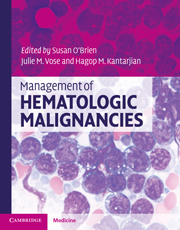Book contents
- Frontmatter
- Contents
- List of contributors
- 1 Molecular pathology of leukemia
- 2 Management of acute myeloid leukemia
- 3 Treatment of acute lymphoblastic leukemia (ALL) in adults
- 4 Chronic myeloid leukemia
- 5 Chronic lymphocytic leukemia/small lymphocytic lymphoma
- 6 Myelodysplastic syndromes (MDS)
- 7 Hairy cell leukemia
- 8 Acute promyelocytic leukemia: pathophysiology and clinical results update
- 9 Myeloproliferative neoplasms
- 10 Monoclonal gammopathy of undetermined significance, smoldering multiple myeloma, and multiple myeloma
- 11 Amyloidosis and other rare plasma cell dyscrasias
- 12 Waldenstrom's macroglobulinemia/lymphoplasmacytic lymphoma
- 13 WHO classification of lymphomas
- 14 Molecular pathology of lymphoma
- 15 International staging and response criteria for lymphomas
- 16 Treatment approach to diffuse large B-cell lymphomas
- 17 Mantle cell lymphoma
- 18 Follicular lymphomas
- 19 Hodgkin lymphoma: epidemiology, diagnosis, and treatment
- 20 Treatment approaches to MALT/marginal zone lymphoma
- 21 Peripheral T-cell lymphomas
- 22 Mycosis fungoides and Sézary syndrome
- 23 Central nervous system lymphoma
- 24 HIV-related lymphomas
- 25 Lymphoblastic lymphoma
- 26 Burkitt lymphoma
- Index
- References
1 - Molecular pathology of leukemia
Published online by Cambridge University Press: 10 January 2011
- Frontmatter
- Contents
- List of contributors
- 1 Molecular pathology of leukemia
- 2 Management of acute myeloid leukemia
- 3 Treatment of acute lymphoblastic leukemia (ALL) in adults
- 4 Chronic myeloid leukemia
- 5 Chronic lymphocytic leukemia/small lymphocytic lymphoma
- 6 Myelodysplastic syndromes (MDS)
- 7 Hairy cell leukemia
- 8 Acute promyelocytic leukemia: pathophysiology and clinical results update
- 9 Myeloproliferative neoplasms
- 10 Monoclonal gammopathy of undetermined significance, smoldering multiple myeloma, and multiple myeloma
- 11 Amyloidosis and other rare plasma cell dyscrasias
- 12 Waldenstrom's macroglobulinemia/lymphoplasmacytic lymphoma
- 13 WHO classification of lymphomas
- 14 Molecular pathology of lymphoma
- 15 International staging and response criteria for lymphomas
- 16 Treatment approach to diffuse large B-cell lymphomas
- 17 Mantle cell lymphoma
- 18 Follicular lymphomas
- 19 Hodgkin lymphoma: epidemiology, diagnosis, and treatment
- 20 Treatment approaches to MALT/marginal zone lymphoma
- 21 Peripheral T-cell lymphomas
- 22 Mycosis fungoides and Sézary syndrome
- 23 Central nervous system lymphoma
- 24 HIV-related lymphomas
- 25 Lymphoblastic lymphoma
- 26 Burkitt lymphoma
- Index
- References
Summary
Introduction
Most of the current knowledge of the molecular basis of leukemias indicates that leukemias are heterogeneous groups of neoplasms. Even when the clinical and phenotypic presentations are similar, biologically the leukemias may differ, and molecular characterization of the individual leukemia is therefore essential for predicting prognosis and determining therapeutic approaches. This observation is not only relevant to leukemias, but is true of the complexity of cancer in general.
With the recent advances in targeted therapy, and the ability to develop more specific inhibitors which target a specific pathway, precise understanding of the molecular abnormalities in a specific leukemia is becoming more crucial. It is widely accepted at this time that leukemia is a disease of hematopoietic cells, occurring when these cells become capable of independent self-renewal irrespective of physiologic needs. Most leukemic processes are believed to be initiated at the level of stem cells. The definition of stem cells varies, however, dependent on the stage of differentiation. For example, it is believed that in some diseases, particularly chronic leukemias, the leukemic process is initiated at the stem cell level, but that the cells manage to differentiate to a certain extent, allowing the disease to manifest as a chronic leukemic process of the mature cells. While some leukemias are characterized and defined by a specific molecular abnormality, considered the hallmark of the disease, most investigators believe that additional molecular abnormalities must accumulate for the disease to manifest itself, or progress to acute disease.
- Type
- Chapter
- Information
- Management of Hematologic Malignancies , pp. 1 - 25Publisher: Cambridge University PressPrint publication year: 2010



